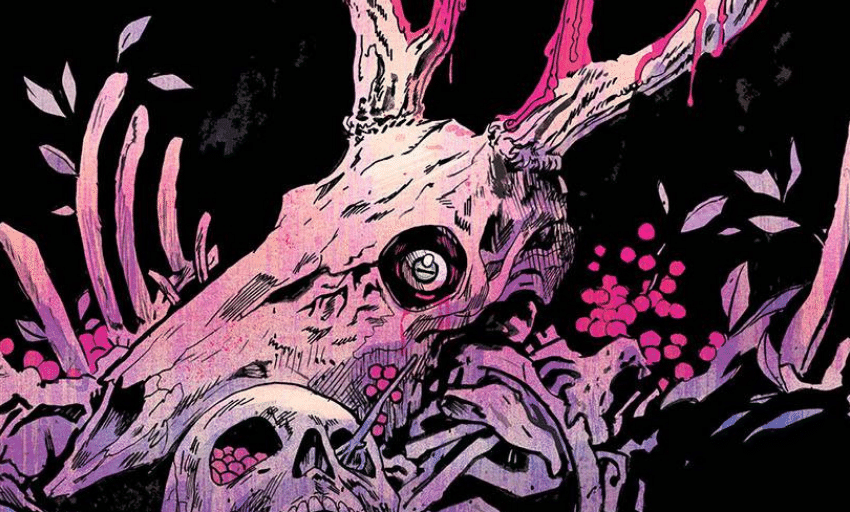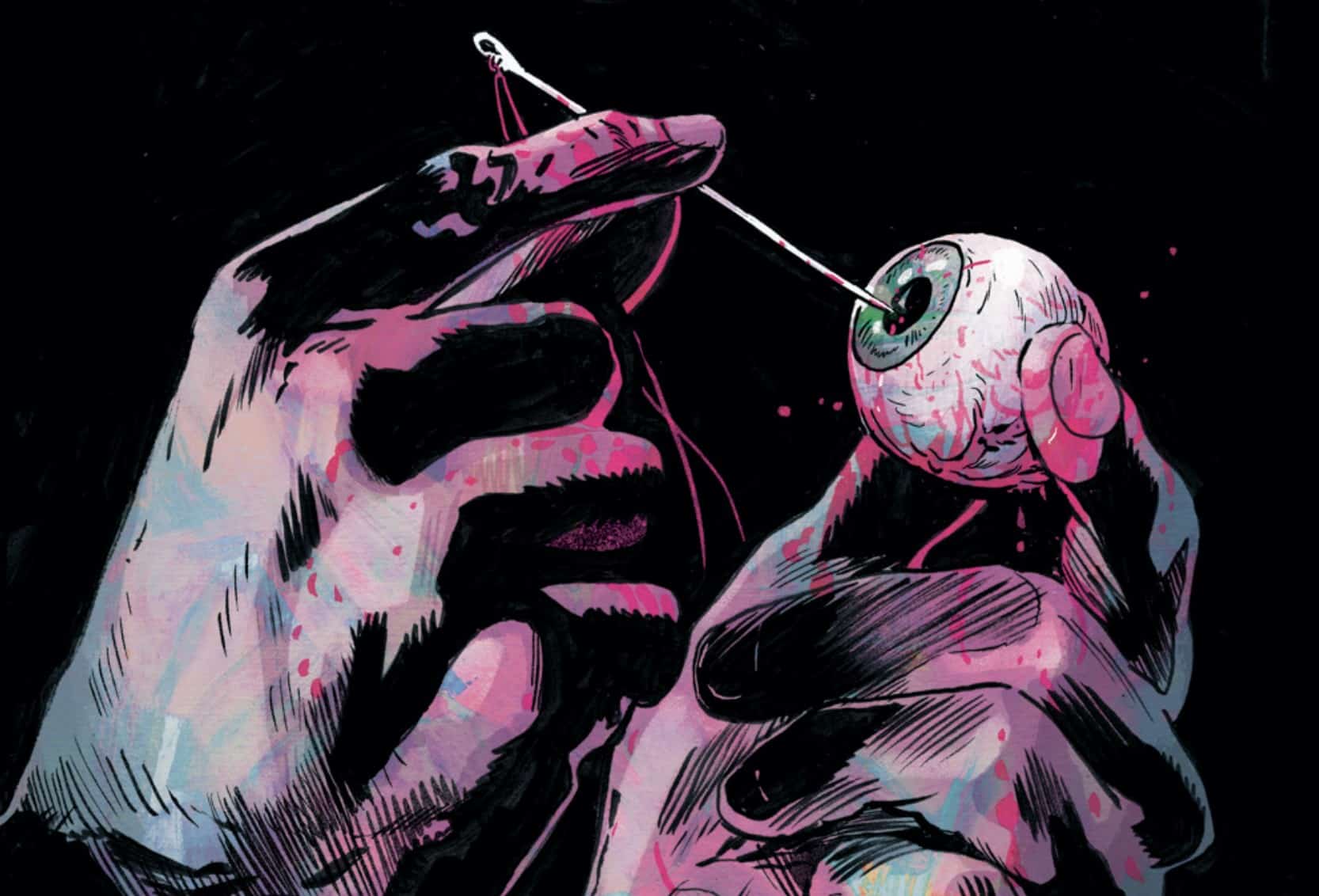In 1993, classic mean girls bully a misfit teen at an idyllic summer camp. When the teen reclaims her power after a violent encounter with the Silver Coin, what follows is the stuff of horror movie legend. It’s Part 2 in the saga of The Silver Coin from artist Michael Walsh and writer Kelly Thompson.
Mark Turetsky: Hey, Armaan! We’re back again for round two of our column, The Silver Convention (That joke would have worked better last time, when disco was a part of the story. Ah well)!
Armaan Babu: Hey, we don’t know what the other issues have in store, maybe we could bring it back! It’s hard to think of good summer camp puns, especially when I’ve never been to any, but if this issue is any indication of what they’re like, I’m glad I missed out!
Bummer Camp

MT: I only ever did day camp myself. Too many psycho killers at summer camp for me.
AB: Nobody told poor Fiona Watterman that the abundance of summer camp serial killers was a real thing, despite her love for horror movies. In fact, the worst thing about the camp seems to be the bullying she’s subjected to from pretty much the moment she gets there.
MT: It’s like Jean-Paul Sartre wrote in Buffy the Vampire Slayer: “Hell is other people.” Are you a big fan of slasher movies, such as the obvious inspiration for this issue, Friday the 13th?
AB: No, but I enjoyed Buffy the Vampire Slayer a whole bunch, especially Sartre’s role in it. The slasher genre is something that’s never quite hooked me, and that may be a large part of why this issue left me cold. Or at least lukewarm.
MT: That’s interesting, because I’m also not a huge slasher fan, but I flat-out loved this one, especially just how far Walsh leaned into the gore. Issue #1’s story, The Ticket, was very well done, but there’s just something about leaning into the visceral aesthetics that appealed to me.
AB: I think what felt flat for me is how straightforward the story felt. Irredeemable bullies get their inevitable comeuppance, in ways that give a whole new meaning to the word “overkill.” But where the story may not have grabbed me, the art definitely continues to, giving me a lot of individual moments that still sent a thrill down my spine.
MT: From the very first page, I just continue to be impressed with Walsh’s colors. The VHS tape interlacing effect, even the evident chromatic aberration (that’s a fancy word for when you get weird colors, especially when you have bright things next to dark things, like you see in the trees behind the killer, usually the result of backlighting and a cheap lens), it all works beautifully. And then a bit later, you get this one page, the “wholesome” page, where the promise of camp is presented in full, warm daylight, which we never really see again. Further scenes in daylight take on cool tones that tell you our little Fiona isn’t really enjoying herself like she should. And that chromatic aberration gets reintroduced during the cabin sequence where the comic takes a turn.
AB: Chromatic aberration. What a beautiful phrase. The very sound of it feels right at home with the art of this book. Walsh also seems to be having fun playing with a lot of other details that just scream “Sinister.” The way the main bully’s bangs keep her face in shadow. The absolutely chilling way her eyes glow out of that shadow when she’s telling Fiona a scary story – it’s not a scene that should work; a wall of very unpoetic text next to a single image, but Walsh completely nails the intensity. And, of course, that purple blur in the eyes of the shadowy figure in the cabin, that adds a sense of unreality to everything.
MT: And throughout, we get the spooky motif of the eyes shining in pitch darkness that was introduced in the first issue. It’s especially effective in the big climactic moment that’s played out in six silhouetted panels toward the end, where you see the mouth of the killer, which then disappears in a moment of clarity. It’s such utterly effective cartooning that you can see the killer’s whole life change so dramatically just with a silhouetted pose.
But What Is the Silver Coin?

AB: Absolutely. It’s interesting, the Coin is acting very differently here. Last issue, it was presented as a sort of temptation. As something that fed, slowly, on blood and ambition, until it built up to a crescendo of devastation. Here, however, it takes a much more direct route, taking control over Fiona in a more direct and horrifying way, not letting her go until its rampage was finished. Does it feel like we’re seeing new rules being applied to the Coin?
MT: It is interesting, yes, just how different this story is. But the coin is still giving its owner power, and in a way helping them to fulfill their desire, right? The comic shows Fiona watching slasher movies with a sort of wholesome innocence at the beginning, and it corrupts it into something much more nefarious. It’s exchanging the emotional thrill of a shared musical experience in the first issue for the raw hurt of sustained bullying. In both cases, the coin is pulling from a deep emotional reservoir and twisting it toward its (literally) bloodthirsty ends.
What I also find interesting is that we now sort of understand the “rules” of this series a bit better. In an anthology like this, it’s hard to say, “This is what this series is about” when you’ve only read one issue. When you have two, you can then start to say, “OK, I guess this is what it’s about.” And then hopefully issue #3 utterly subverts those expectations.
AB: I have to say, you’re really selling me on this issue pointing out a few things that went right over my head. I think that’s what makes the series so fascinating — it’s that no matter how horrific the Coin makes things, it remains alluring. The idea that it can take something twisted, buried deep inside of you by your own weakness, and pull it out to manifest it into something raw and powerful. Even knowing what the Coin brings — it’s still a temptation.
MT: Well, I think I’ve done my work as a critic if I can convince another critic that a comic they didn’t like is actually good. Does this mean I win the review? This is a competition, right?
AB: If it is, you’re clearly winning. I have three more issues with which to come out ahead, and while I was looking forward to them already, now we have stakes.
Loose Change

- Walsh makes great use of sound effects, but some of his most powerful work continues to be in bringing the feeling of sound to silent panels. Fiona’s final scream rips right off the page.
- I feel bad for the camp counselor. She seemed so nice! (Well, I guess she was wilfully ignoring some pretty obvious and heinous abuse.)
- We almost forgot to mention our rooftop raven that seems to follow the coin around — there’s something going on there beyond just ominousness. Maybe we’ll find out in the finale, written by Walsh himself.
- Next month: It’s Ed Brisson, so we get a crime comic!







